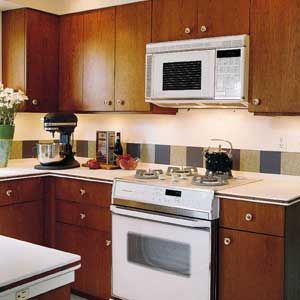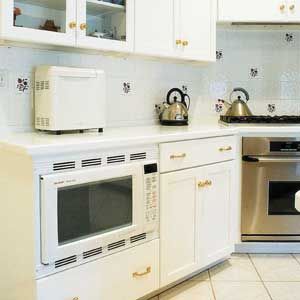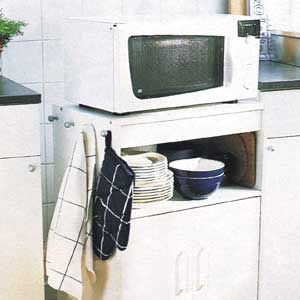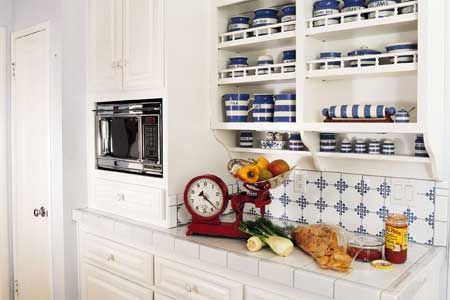Since its invention in the mid-1950s, the microwave has become an essential appliance in modern kitchens. From countertop models to built-in units, finding the right spot for your microwave can significantly impact your kitchen’s functionality and safety. This guide will explore various microwave placement solutions, helping you make an informed decision that suits your kitchen layout, lifestyle, and design preferences.

Microwave Placement in Modern Kitchens
Initially, microwaves were primarily countertop units, taking up valuable workspace. As kitchens evolved, so did microwave installation options. Today, you’ll find microwaves mounted over ranges, built into cabinets above and below counters, and even integrated into kitchen islands.
What To Consider When Choosing a Microwave Location
When deciding where to place your microwave, these considerations will help ensure that your microwave is not only conveniently located but also safe and easy to use for all household members.
Ergonomics and Accessibility
The height at which you place your microwave is key for comfortable and safe use. According to Rhonda Moritz, spokeswoman for the National Kitchen & Bath Association (NKBA), “The NKBA’s official guidelines recommend placing the shelf or cabinet the microwave sits on well below eye level, at 24 to 48 inches off the ground.” This placement ensures that most users can easily reach the microwave without straining or risking spills.
Safety Concerns
Safety should be a top priority when choosing your microwave’s location. Avoid placements that require reaching over hot surfaces or that might be difficult for children or elderly family members to access. Consider the potential for spills and burns, especially when removing hot items from the microwave.
Kitchen Layout and Workflow
Your microwave’s location should complement your kitchen’s workflow. For convenience, place it near food prep areas and refrigerators. In efficient galley kitchens, consider how the microwave fits into the overall layout to maximize space and minimize traffic congestion.
Popular Microwave Placement Options
There are several common placement options for microwaves, each with its own set of advantages and considerations.
Over-The-Range Installation
While popular, over-the-range microwave placement has some drawbacks. Chet Basher, a kitchen designer in Sparta, New Jersey, notes, “You can lower an over-the-range microwave so that it’s more ergonomically correct, but then you can’t use tall pots on the back burners.” This placement can also be challenging for shorter individuals or those with mobility issues.

Above-Counter Solutions
Placing the microwave above the counter, either built into a wall or on an elevated portion of an island, offers improved accessibility. This option is particularly convenient for children, elderly users, and those with disabilities. It also provides quick access to counter space for food preparation and plating.

Under-Counter Configurations
Under-counter microwave placement is gaining popularity, especially in kitchens with limited counter space. Glen Doyle, of Glen Doyle Builders in Princeton, New Jersey, observes, “When I bring up this option to people, they’re skeptical. But, believe it or not, it’s really very efficient. ” This solution works well for many households, but may not be ideal for homes with very young children or elderly members who have difficulty bending.

Microwave Drawer Options
Microwave drawers are a modern solution that combines the benefits of under-counter placement with improved ergonomics. These units slide out like a drawer, making it easy to place and remove dishes without bending or reaching. They’re an excellent option for universal design kitchens and can be seamlessly integrated into kitchen islands or lower cabinets.

Maximizing Microwave Space in Small Kitchens
In smaller kitchens, creative microwave placement is essential to maximize available space and maintain a functional layout.
Creative Storage Solutions
Consider using a microwave cart with wheels for flexibility in small spaces. This option allows you to move the microwave as needed and often provides additional storage. Just ensure the cart has a heat-resistant surface and raised edges to prevent accidents.
Multi-Functional Kitchen Appliances
To save space, look for appliances that combine multiple functions. Some easy kitchen upgrades include installing a microwave-convection oven combo or a microwave with built-in air fryer capabilities. These multi-functional appliances can help reduce clutter and maximize functionality in compact kitchens.
Wall-Mounted Microwaves
Another space-saving solution is mounting the microwave on the wall. This idea can help free up counter space while keeping the microwave within easy reach. Wall-mounted microwaves are available in various designs to fit different kitchen layouts and styles, offering another versatile option.
Ventilation Requirements for Microwave Placement
Proper ventilation is necessary for the safe and efficient operation of your microwave, especially for built-in models.
Built-In Microwave Ventilation Needs
Sam Cipiti, vice president of R. M. Tunis Kitchens and Baths in Chevy Chase, Maryland, advises, “The manufacturer’s instructions will tell you how much cabinet depth you need for a built-in. It’s usually at least 15 inches.” This space allows for proper air circulation and prevents overheating.
Ensuring Proper Air Circulation
For built-in microwaves, trim kits can provide at least 1 1/2 inches of ventilated space around the unit. This extra space ensures adequate airflow, which is essential for the appliance’s longevity and safe operation. Always follow the manufacturer’s guidelines for installation and ventilation requirements.
External Venting Options
If your microwave supports external venting, you might need to install ductwork to vent the hot air outside. This option is particularly useful for over-the-range microwaves that double as range hoods. Make sure to consult the installation manual and, if necessary, hire a professional to handle the venting to ensure it meets local building codes and functions effectively.
Design Considerations for Seamless Microwave Integration
Integrating your microwave into your kitchen design can enhance the overall aesthetic and functionality of the space.
Matching Microwave Style with Kitchen Aesthetics
Choose a microwave that complements your kitchen’s style. Stainless steel models are popular for modern kitchens, while built-in units with custom panels can blend seamlessly with traditional cabinetry.
Custom Cabinetry Solutions
Custom cabinetry can provide tailored solutions for microwave placement. This approach allows you to create a dedicated space for your microwave that perfectly fits your kitchen’s design and your specific needs. Options include pull-out shelves, hidden compartments, or specially designed nooks that keep the microwave accessible yet out of sight when not in use.
Technology Integration
Modern microwaves feature touch screens, smart home compatibility, voice control, and more. When selecting a microwave, consider how these technologies enhance your kitchen experience.
Microwave Placement for Special Needs
When planning microwave placement, it’s important to consider the needs of all household members, including those with special requirements.
Accommodating Users With Limited Mobility
For users with limited mobility, microwave placement should prioritize ease of access and safety. Under-counter or countertop placements at a comfortable height can be ideal. Avoid locations that require reaching or bending, and ensure there’s ample counter space nearby for setting down hot dishes.
Child-Friendly Microwave Locations
If you have children in the home, consider placing microwaves out of reach for very young children or at a safe height for older kids who are learning to use the appliance. A microwave drawer or a lower built-in unit can be a good option, allowing supervised use while minimizing the risk of spills or burns.
ADA-Compliant Kitchen Designs
Accessible design is crucial for creating a kitchen that everyone can use. If you have household members with mobility issues or disabilities, consider consulting resources about kitchens that are compliant with the Americans with Disabilities Act (ADA). Incorporating these principles in your kitchen ensures that the microwave and other appliances are usable by everyone in the home, promoting independence and safety.
Our Conclusion
Choosing the right microwave placement is essential for creating a functional, safe, and efficient kitchen. By considering factors such as ergonomics, safety, kitchen layout, and the needs of all household members, you can find a solution that enhances your kitchen’s usability and design. With careful planning, your microwave can become a seamlessly integrated part of your kitchen, contributing to both its functionality and style.

